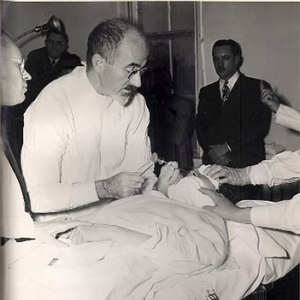
About the Book
-
Author:
- Howard Dully
- Genre:
- Memoir / Biography
- Voices:
- Cis Boy
- Straight
- White (Non-Specified)
Cover Story: Different Kind of Needle
Drinking Buddy: A Bottle in Front of Me…
MPAA Rating: R (drug use, sexuality, medical malpractice)
Talky Talk: How? Why?
Bonus Factor: Dr. Walter Freeman
Bromance Status: The Book That Could Kick My Books’ Asses
Cover Story: Different Kind of Needle
According to the jacket, this is a stock photo, and there’s not much about record players in the book. Some versions have a real photo of young Howard on the cover.
The Deal:
In 1960, Dr. Walter Freeman performed a transorbital lobotomy on Howard Dully. Dully was twelve years old at the time.
In case you’re not familiar with the procedure, a lobotomy involves sedating the patient (in Dully’s case, they used electroshock treatment), then inserting an ice pick-like instrument (or an actual ice pick) into the eye socket. After perferating the delicate bone of the orbit, the doctor severs the frontal lobes of the brain.
They used to do this as a cure for mental illness in the 1940s and 50s. Tens of thousands of lobotomies were performed in the US alone.
Dully was lobotomized because his stepmother reported that he was awkward, defiant, lazy, and did not get along with his siblings and parents. In other words, he was twelve.
Suprisingly, the lobotomy did not cure Dully of his problems, and he wound up institutionalized, in jail, and homeless. Years later, Dully was determined to discover why he’d had part of his brain removed.
Drinking Buddy: A Bottle in Front of Me…

Dully doesn’t have a lot of memories before he turned twelve (I wonder why), and relies on his brothers and step-brother to fill in the blanks. It’s only after his brain surgery that he develops any sort of personality. And it’s not that great. He steals, he does drugs, he drifts around California, all the while hiding the fact that he’d been lobotomized.
When I tell people about this book, they’re often shocked that someone who’d had this surgery could read a book, let alone write one. That was the psychosurgery crap shoot: sometimes the patient calmed down. Sometimes they didn’t. Sometimes they calmed down so much they stopped being able to speak and feed themselves. And sometimes they died. The surgery had a fatality rate as high as 15%.
Dully, with help from some NPR reporters, managed to track down his medical records, including this really disturbing image of his twelve-year-old self getting the ice pick treatment. And he wrote a book about it.
I’ll remember this next time I complain how hard it is to be a writer.
MPAA Rating: R (drug use, sexuality, medical malpractice)
So Dully’s stepmother apparently had some kind of vendetta against him. She’d spoken to several psychologists about her stepson’s problems, and was told she could do with some therapy herself. So when she met Dr. Freeman, she got a little creative, making up stories about Howard attacking his baby brother and repeatedly soiling his pants. In fact, Dully spent most of his adult life wondering if maybe he hadn’t done something horrible that he could no longer remember. Why else would his father, a school teacher, agree to this surgery?
At any rate, it took a true pill popper lunatic visionary like Dr. Freeman to take the next logical step: brain surgery.
When nothing really changed afterward (and Howard grew to be a physically intimidating young man), the Dullys had Howard committed. He then wound up in a kind of live-in reform school, got kicked out, wound up on the streets, ran with a biker gang, did drugs, rebuilt car engines in his living room, got married, divorced, and had a couple of kids. He tried his hand at criminal activities, but was really bad at it (if you’re going to sell stolen goods at the pawn shop, don’t give your real name and address).
Eventually he got married again to a woman who helped him straighten out his life and face the past.
Talky Talk: How? Why?
So why did society allow this sort of surgery to go on? I mean, who’d permit a doctor to ice pick a preteen?
Dully explains it well. After the Second World War, hospitals were flooded with the mentally ill. And no one knew what to do with them, besides put them in restraints. When Dr. Freeman showed up with his Harold Hill cure for everything, hospitals were willing to listen. It became the surgery of choice. Rosemary Kennedy, sister of the future president, was lobotomized in 1941.
Then, in the 1950s, anti-psychotic drugs were developed. Like leeching and trepanning, the procedure died forever.
It’s amazing to hear the story of one of the few patients who underwent the surgery and was able to talk about it afterward.
Bonus Factors: Dr. Walter Freeman

So Dully wasn’t lobotomized by just any old clown, but the man who invented the transorbital procedure. After learning about the leucotomy–a lobotomy forerunner that required drilling through the skull–Freeman went all in. He developed the technique of going in through the eye sockets. He toured the country in his ‘lobotomobile’ (I wish I was making that up). He’d stop at hospitals and lobotomize patients at thirty bucks a head…so to speak.
Freeman was a photography fan, and would stop in the middle of the procedure to snap pictures. And yes, sometimes the instruments would slide into someone’s brain while he was setting up the camera.
Dully relates how Freeman had him and two other lobotomized children accompany him to a lecture at a doctors’ meeting. When the audience realized what Freeman had done to the kids, he was booed off the stage.
Freeman lost his medical license when a patient died while he was lobotomizing her for the third(!) time.
António Egas Moniz, the Portuguese doctor who originated the leucotomy, won the Nobel Prize in medicine in 1949, the same year he was shot by one of his patients.
Bromance Status: The Book That Could Kick My Books’ Asses
Hey, my books are about teenage problems too! They’re serious…oh, never mind. Here’s my lunch money.
Literary Matchmaking

A slightly more cheerful childhood memoir.
FTC Full Disclosure: I read this book at the library, where all books are free. I received no money or beer. My Lobotomy is available now.